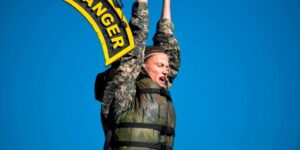This blog was originally published on March 13, 2015.
 When Massachusetts representative, Edith Nourse Rogers, introduced a bill in May 1941 to establish a Women’s Army Auxiliary Corps for Service with the Army of the United States she set into motion a series of events that transformed the role of women in military service. (HR 4906, 77th Congress, 1st session) Rogers had served in the American Red Cross in France during World War I, and she was inspired by the contributions of English women to the war effort.
When Massachusetts representative, Edith Nourse Rogers, introduced a bill in May 1941 to establish a Women’s Army Auxiliary Corps for Service with the Army of the United States she set into motion a series of events that transformed the role of women in military service. (HR 4906, 77th Congress, 1st session) Rogers had served in the American Red Cross in France during World War I, and she was inspired by the contributions of English women to the war effort.
By the summer of 1941 General Marshall was intensely interested in the WAAC initiative. General John. H. Hilldring, a member of Marshall’s general staff, said Marshall’s interest was based on the fact that he “had a passionate regard for democratic ideals.” While Marshall didn’t see an immediate need for large numbers of women in the Army, he foresaw a cycle of shortages, and he thought it best to have the authorization on the books so that if the “need for quick action should arise, the point of debate would be past.”
Mrs. Rogers’ bill was stuck in the House Rules Committee for days, but the members eventually yielded because they dared not oppose the opinion of the Army Chief of Staff on matters of national defense. However, when the measure hit the floor of the House, real opposition developed. One member argued, “Take the women into the armed service, who then will do the cooking, the washing, the mending, the humble homey tasks to which every woman has devoted herself? Think of the humiliation! What has become of the manhood of America?” (Congressional Record Vol. 88 No. 55, 17 Mar 1942) General Hilldring thought the only reason the bill was saved was because it had the personal support of both the Chief of Staff and the Secretary of War.
The Women’s Army Auxiliary Corps was intended for non-combatant services and not considered part of the Army. Even though Mrs. Rogers stated “in the beginning I wanted very much to have these women taken in as a part of the Army . . . I wanted them to have the same rate of pension and disability allowance. I . . . realized that The War Department was very unwilling to have these women as part of the Army.”
However, women proved themselves very capable and in March 1943 Congress opened hearings on the conversion of the WAAC into the Regular Army. When a WAAC re-enlisted to become a WAC (Women’s Army Corps), she was finally entitled to the same pay, the same benefits and privileges as well as being subjected to the same disciplinary code as a male soldier. The only positions a WAC could not accept were those that were labeled combat.
 The WAC remained in operation until 1978, even though it was supposed to be deactivated six months after the end of World War II. On October 1, 1979 all enlistment qualifications became the same for men and women by order of the Secretary of the Army.
The WAC remained in operation until 1978, even though it was supposed to be deactivated six months after the end of World War II. On October 1, 1979 all enlistment qualifications became the same for men and women by order of the Secretary of the Army.
Even 74 years after the beginning of the WAACs, not all combat MOSs (military occupational specialty) are open to women. The most recent advancement for women in combat roles happened this past January when Secretary of the Army John McHugh approved the participation of women in the spring 2015 Ranger course. As of February 25th, 2015, there were six women who qualified for Army Ranger School by completing the Ranger Training Assessment Course at Fort Benning, Georgia.
For more primary sources about WACs from the Foundation’s Library and Archives, please see the Women’s Army Corp Research Subject Guide.
